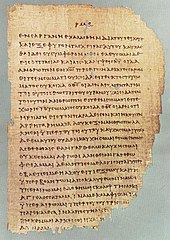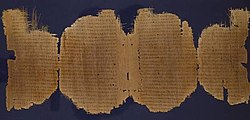Gospel of Luke
| Books of the New Testament |
|---|
 |
| Gospels |
| Acts |
| Acts of the Apostles |
| Epistles |
|
Romans 1 Corinthians · 2 Corinthians Galatians · Ephesians Philippians · Colossians 1 Thessalonians · 2 Thessalonians 1 Timothy · 2 Timothy Titus · Philemon Hebrews · James 1 Peter · 2 Peter 1 John · 2 John · 3 John Jude |
| Apocalypse |
| Revelation |
| New Testament manuscripts |
The Gospel according to Luke (Greek: Εὐαγγέλιον κατὰ Λουκᾶν, romanized: Euangélion katà Loukân[1]), also called the Gospel of Luke, or simply Luke, tells of the origins, birth, ministry, death, resurrection, and ascension of Jesus Christ.[2] Together with the Acts of the Apostles, it makes up a two-volume work which scholars call Luke–Acts;[3] together they account for 27.5% of the New Testament.[4]
The combined work divides the history of first-century Christianity into three stages, with the gospel making up the first two of these – the life of Jesus the Messiah from his birth to the beginning of his mission in the meeting with John the Baptist, followed by his ministry with events such as the Sermon on the Plain and its Beatitudes, and his Passion, death, and resurrection. Most modern scholars agree that the main sources used for Luke were (a) the Gospel of Mark, (b) a hypothetical sayings collection called the Q source, and (c) material found in no other gospels, often referred to as the L (for Luke) source.[5]
The author is anonymous;[6] the traditional view that it was Luke the Evangelist, the companion of Paul, is still occasionally put forward, but the scholarly consensus emphasises the many contradictions between Acts and the authentic Pauline letters.[7][8] The most probable date for its composition is around AD 80–110, and there is evidence that it was still being revised well into the 2nd century.[9]
Composition[]
Textual history[]

Autographs (original copies) of Luke and the other Gospels have not been preserved; the texts that survive are third-generation copies, with no two completely identical.[10] The earliest witnesses (the technical term for written manuscripts) for Luke's gospel fall into two "families" with considerable differences between them, the Western and the Alexandrian text-type, and the dominant view is that the Western text represents a process of deliberate revision, as the variations seem to form specific patterns.[11]